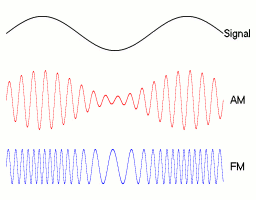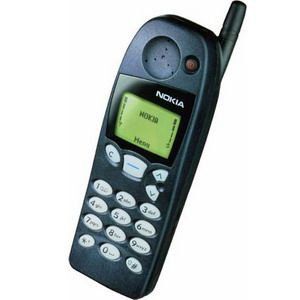What is the difference between different cellular networks like 4G and 5G?
Analog Networks and Phone Calls (0G-1G)
The first cellular network (MTA, Mobiltelefonisystem A) was introduces in Sweden in 1956. In practice, the phones were so large that they were really only installed into cars but the cell towers still communicated wirelessly with these car phones. Although it was possible to move around within the range of the cell tower, the connection was lost if the phone needed to connect to a different tower. The network had approximately 125 users in Stockholm and Gothenburg.
The so called first generation cellular networks (1G) transferred sound as an analogue signal using a modulated carry wave. For example, if we wanted to send a simple 100 Hz wave, we could combine it with a considerably higher frequency 850 MHz carry wave. Combining the waves was done with amplitude modulation (AM) or frequency modulation (FM).
When using amplitude modulation, the amplitude of the carry wave is changed based on the transferred data. Frequency modulation is similar but we change the frequency of the carry wave instead.

Connecting phone calls with this technology required a specific frequency band which is defined by the lowest and highest used frequencies. If someone is on the phone on some frequency band, everyone else has to use a different band or the the signals could interfere with each other. The more frequencies a cell tower uses, the more people can make phone calls simultaneously. This is called bandwidth.
As the amount of users rose, the network was constantly put under a test. One option to fix the issue could be introducing more frequency bands to widen the bandwidth but this approach is problematic. All radio and TV stations, military systems, GPS and other systems utilizing electromagnetic waves need their own frequency bands which makes it extremely expensive for network providers to reserve new frequency bands for cell towers. Yet, network providers have used this approach at every stage of the development of the network
However, over the years, a lot of work has also been done to ensure that as much data as possible can be transmitted in each frequency band. The simples approach is to build more cell towers. Instead of using a single powerful tower to cover entire cities, multiple less powerful towers can be used. This makes it possible to use the same frequency bands for different users because the signal of these lower powered cell towers won’t reach far enough to interfere with each other.
This made it possible to increase the amount of users but the speed of data transfer still remained low. The best 1G networks were able to transmit data at the speed of 2,4 kbps.
Digital Networks and Text Messaging (2G)
The 2G network was eventually developed and it took full advantage of the digital system and ushered in the actual era of mobile phones, replacing the era of car phones. If you’re my age or older, the 2G era is likely when you got your first mobile phone. My first phone was the magnificent Nokia 5110. It sure allowed me to make phone calls but it also came with a completely new way of communication, text messaging.

When 2G was introduced, it was able to transmit data at the speed of 9.6 kbps and text messaging worked smoothly. Before 3G, the speed of 2G was already 200 kbps, thanks to a new technology called GPRS (General Packet Radio Switching) which is sometimes referred to as 2.5G.
Wireless internet (3G)
The next generation of mobile networks, 3G, further utilized new frequency bands. It’s been estimated that European network providers spent more than 100 billion euros during this time period to reserve new frequencies for their networks.
Additionally, 3G made very efficient use of packet switching technology that GPRS had previously utilized. It allowed thousands of people use the same frequency bands more efficiently by splitting the data into small data packets that could be sent via different frequency bands as small chunks. Instead of having to wait for a frequency band to become completely vacant, it was now possible to send small chunks of data whenever a frequency band had any space on it. This made data transfer speeds much larger and allowed more concurrent users to use the network.
In 2005, yet another new technology, HSPA (High Speed Packet Access) was introduced. You may have seen H+ text on your phone, indicating that using this technology HSPA. This technology is sometimes called 3.5G and it already allowed a speed of 42 Mbps (42 000 kbps).
High Definition Streaming (4G)
The next generation brought along yet another new technology, LTE (Long Term Evolution), which utilized new 700 MHz frequency bands that were previously used by analog TV broadcasts. In addition, a new technology, OFDM (Orthogonal Frequency Division Multiplexing), was introduced to transmit even more data in a single frequency range using some sort of black magic (math that goes way beyond my engineering degree).
When you really think about it, isn’t it absolutely amazing that we can stream HD videos with our phones without a single cable. Yet, the quality of these videos keeps getting better while simultaneously more and more devices from televisions to industrial robots are connected into the wireless internet. Even the current technologies don’t seem to be able to transmit enough data and network providers are forced to start using frequency bands nobody wants to use: high frequency millimeter waves.
Internet of Things (5G)
Nobody has previously wanted to use high frequency millimeter waves on the cellphone networks because they are very poor at penetrating pretty much anything including things like rain. This is why network providers have to build and install a large number of new cell towers which seems scary to many consumers.
Adding more towers helps with congestion of frequency bands but 5G also utilizes a new technology called massive MIMO (multiple-input, multiple-output). It allows sending signals directly towards the receiver a bit like a light beam instead of sending it everywhere. 5G will allow us to reach speeds of up to 1000 Mbps (1 000 000 kbps).
5G will increase the speed of data transfer and minimize congestion on the networks. This is essential for new technologies like self driving cars and internet of things.
Finally: 5G is not dangerous
At the extreme end of electromagnetic radiation is gamma radiation, which has a huge frequency. Larger frequency means more energy and gamma radiation is known for causing cancer. Even a bit lower frequency radiation can cause radiation if it’s ionizing meaning it has enough energy to rip electrons off of our cells.
However, the frequencies 5G utilizes are nowhere near ionizing. In fact, the frequencies are lower than the frequency of normal visible light. So, before you start worrying about 5G radiation, you should probably worry about ceiling lamps that are everywhere around us because they are emitting radiation with an even higher frequency than that of 5G networks!